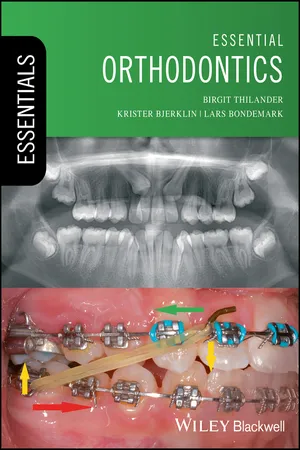Orthodontic panorama
Orthodontics is an old speciality that has undergone dramatic changes during the last 50 years, from being a discipline aimed at treating malocclusions in children to being a discipline aimed at treating patients irrespective of age. Who are then the prospective orthodontic patients? Where do they come from? Why do they come for treatment? Indeed, they make up a miscellaneous collection of individuals of varying ages, with different types of malocclusions, with different family histories, and with different social and cultural backgrounds, factors that naturally will influence the individual's response to orthodontic treatment strategies. Broadly speaking, they can be divided into the following categories that correspond with their special problems: children and teenagers, adults, children with cleft-lip-palate defects and children with disabilities.
The largest group consists of children and teenagers, about 70% of whom are estimated to have some type of malocclusion or tooth anomaly; however, this does not necessarily imply that all those individuals need orthodontic treatment. Treatment depends upon the anomaly, and some diagnosed at an early age have anomalies that may self-correct, while others can get worse. Therefore, it is important for regular examinations and check-ups during the dentofacial growth period, preferably starting at the early ages.
The development of dentition in the growing face is a complex process, as consequently there are many aspects of this process that can go wrong. It is thus of utmost importance that the general dentist is well up-to-date with a high level of knowledge of the classification of malocclusions and craniofacial growth and development. Nevertheless, it must be stressed that there are highly individual variations in dental and physical development, as well as in psychological maturity in children that deserve attention when performing an orthodontic procedure. For example, a treatment performed most effectively at an early age may involve another type of orthodontic procedure if postponed.
In most countries, the general dentist has the responsibility to take the necessary steps to provide care for the patient. If a malocclusion is diagnosed, he/she can consult an orthodontist and in some simple cases do the treatment him/herself under the supervision of the orthodontist. However, in most cases, the patient must be referred to a specialist for the best possible outcome, as children and teenagers with their parents currently demand a high extent of qualified orthodontic care. In other care systems or countries, it is normal that the patient and parents take the initiative to consult an orthodontist.
An increasing number of adults are seeking orthodontic correction of untreated malocclusions, irregularity of teeth, and late-developed crowding of teeth, as well as relapses of previous orthodontic treatment. The reason expressed by almost all of them is a desire for aesthetic improvement of dentofacial anomalies that, in many subjects, may cause psychosocial problems. One factor that should be stressed in relation to the demand for orthodontic treatment is the general social progress with emphasis on individual appearance and aesthetics. It is well known that treatment of severe malocclusions or dental anomalies positively affects a person's self esteem and psychological well-being, and for that reason, even treatment of minor deviations is justifiable in some sensitive individuals.
Consultations are also sought by dentists to align teeth and improve the position of the remaining teeth to facilitate prosthetic restorations, for realignment of teeth caused by pathological tooth migration, or in surgical treatment of severe malocclusions. This indicates that orthodontic treatment in those individuals is aimed at occlusal stability and chewing comfort. A comprehensive analysis and treatment plan must be based on a discussion between the orthodontist and the dentist who is responsible for the periodontal, prosthodontic or surgical procedures. Both have to come to an agreement about the optimal goal for the patient, including financial considerations. A schedule including the various steps of the treatment is presented to the patient, who will be informed in detail about the time of each step in the total procedure. The patient will be instructed to follow an oral hygiene programme to avoid possible dental and gingival damage during the orthodontic treatment, and a strongly motivated adult patient will cooperate excellently. Not until these steps have been taken, can the treatment start.
Demographic considerations demonstrate that the median age of the population will increase. Thus, the orthodontist should develop the skills necessary to manage the increasing number of interdisciplinary adult orthodontic patients, not only from an orthodontic horizon but...
